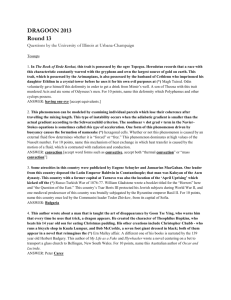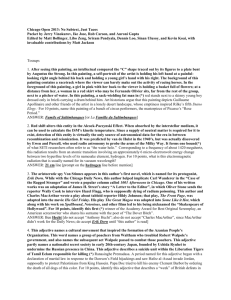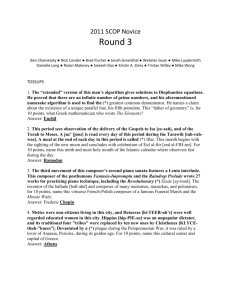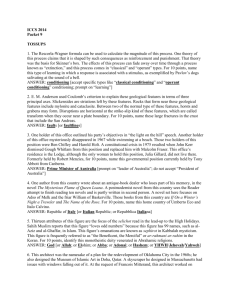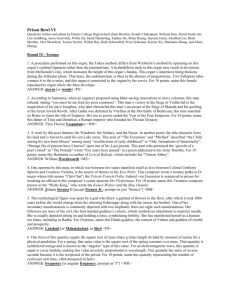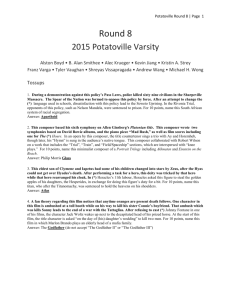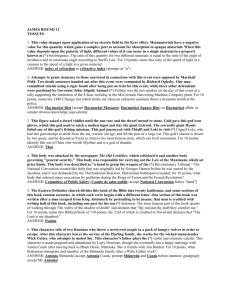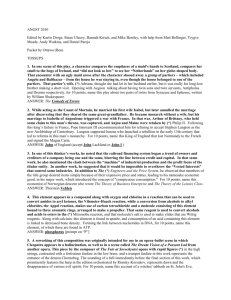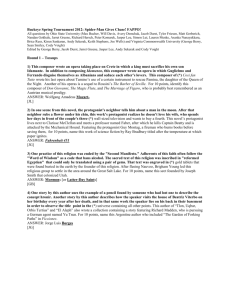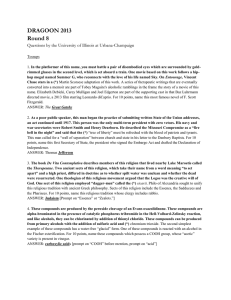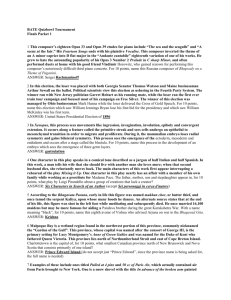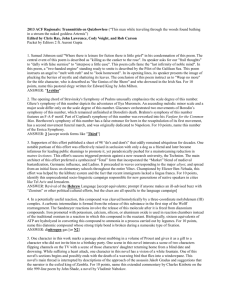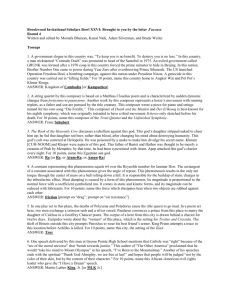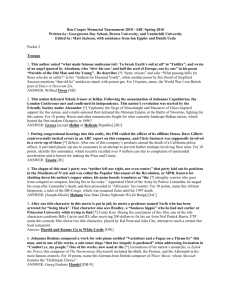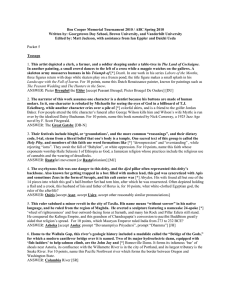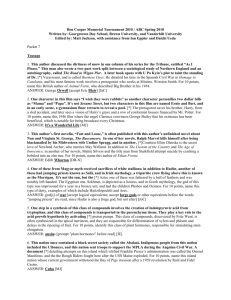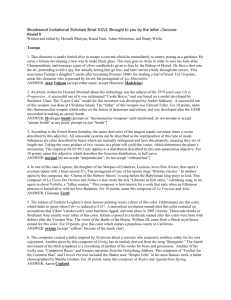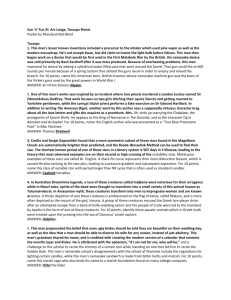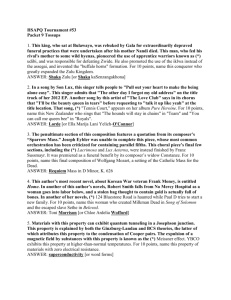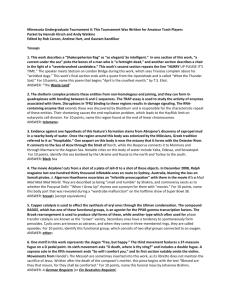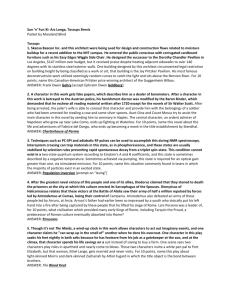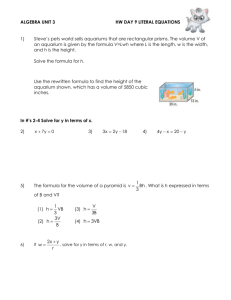(Finals 1). - Collegiate Quizbowl Packet Archive
advertisement
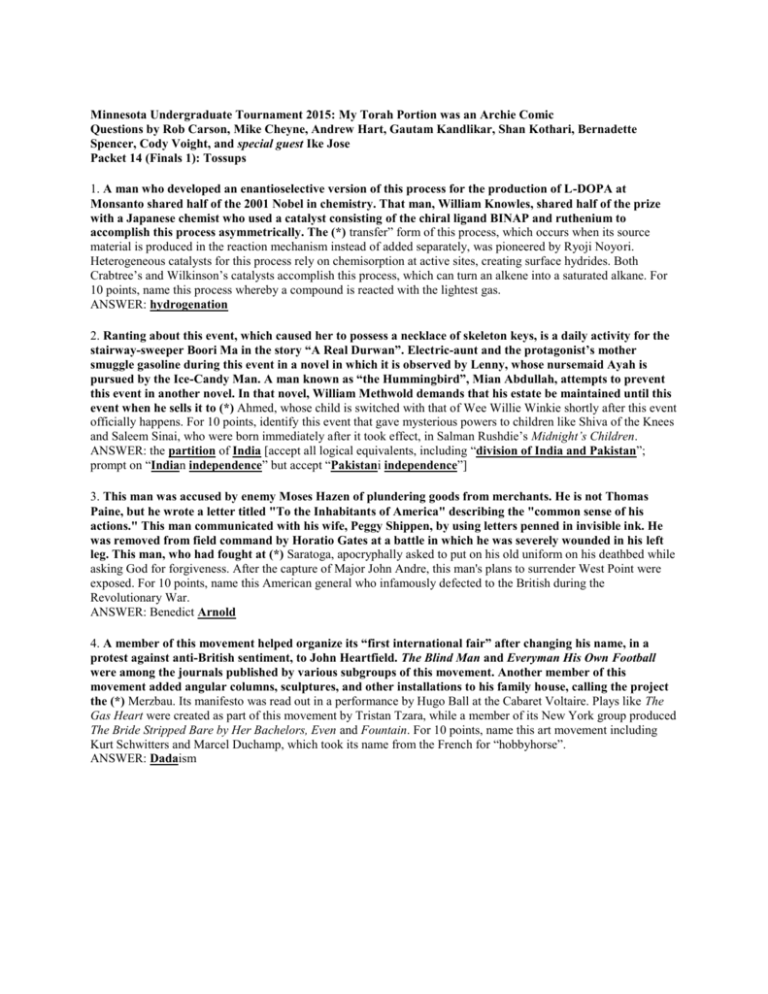
Minnesota Undergraduate Tournament 2015: My Torah Portion was an Archie Comic Questions by Rob Carson, Mike Cheyne, Andrew Hart, Gautam Kandlikar, Shan Kothari, Bernadette Spencer, Cody Voight, and special guest Ike Jose Packet 14 (Finals 1): Tossups 1. A man who developed an enantioselective version of this process for the production of L-DOPA at Monsanto shared half of the 2001 Nobel in chemistry. That man, William Knowles, shared half of the prize with a Japanese chemist who used a catalyst consisting of the chiral ligand BINAP and ruthenium to accomplish this process asymmetrically. The (*) transfer” form of this process, which occurs when its source material is produced in the reaction mechanism instead of added separately, was pioneered by Ryoji Noyori. Heterogeneous catalysts for this process rely on chemisorption at active sites, creating surface hydrides. Both Crabtree’s and Wilkinson’s catalysts accomplish this process, which can turn an alkene into a saturated alkane. For 10 points, name this process whereby a compound is reacted with the lightest gas. ANSWER: hydrogenation 2. Ranting about this event, which caused her to possess a necklace of skeleton keys, is a daily activity for the stairway-sweeper Boori Ma in the story “A Real Durwan”. Electric-aunt and the protagonist’s mother smuggle gasoline during this event in a novel in which it is observed by Lenny, whose nursemaid Ayah is pursued by the Ice-Candy Man. A man known as “the Hummingbird”, Mian Abdullah, attempts to prevent this event in another novel. In that novel, William Methwold demands that his estate be maintained until this event when he sells it to (*) Ahmed, whose child is switched with that of Wee Willie Winkie shortly after this event officially happens. For 10 points, identify this event that gave mysterious powers to children like Shiva of the Knees and Saleem Sinai, who were born immediately after it took effect, in Salman Rushdie’s Midnight’s Children. ANSWER: the partition of India [accept all logical equivalents, including “division of India and Pakistan”; prompt on “Indian independence” but accept “Pakistani independence”] 3. This man was accused by enemy Moses Hazen of plundering goods from merchants. He is not Thomas Paine, but he wrote a letter titled "To the Inhabitants of America" describing the "common sense of his actions." This man communicated with his wife, Peggy Shippen, by using letters penned in invisible ink. He was removed from field command by Horatio Gates at a battle in which he was severely wounded in his left leg. This man, who had fought at (*) Saratoga, apocryphally asked to put on his old uniform on his deathbed while asking God for forgiveness. After the capture of Major John Andre, this man's plans to surrender West Point were exposed. For 10 points, name this American general who infamously defected to the British during the Revolutionary War. ANSWER: Benedict Arnold 4. A member of this movement helped organize its “first international fair” after changing his name, in a protest against anti-British sentiment, to John Heartfield. The Blind Man and Everyman His Own Football were among the journals published by various subgroups of this movement. Another member of this movement added angular columns, sculptures, and other installations to his family house, calling the project the (*) Merzbau. Its manifesto was read out in a performance by Hugo Ball at the Cabaret Voltaire. Plays like The Gas Heart were created as part of this movement by Tristan Tzara, while a member of its New York group produced The Bride Stripped Bare by Her Bachelors, Even and Fountain. For 10 points, name this art movement including Kurt Schwitters and Marcel Duchamp, which took its name from the French for “hobbyhorse”. ANSWER: Dadaism 5. One of these people was a constant companion of Agvan Dorzhiev and received a seven-shot pistol as a gift from Mannerheim. Another died shortly after being kidnapped by Lha-Bzang Khan. One of these people was a student of Je Tsongkhapa who was promised protection by Palden Lhamo. Oracular visions of these people are often seen in the lake (*) Lhamo Latso. One was confirmed as a child after identifying a number of relics owned by the previous one; that man is the subject of the movie Kundun. The next of these people is legally forbidden to be born outside Chinese soil, and the current one has been in exile in Dharamsala since 1959. For 10 points, name this reincarnated leader in the Gelug school of Tibetan Buddhism, the 14th and current of whom is Tenzin Gyatso. ANSWER: Dalai Lama [prompt on “Lama”] 6. This piece of music plays during a scene in which a man rolling red billiard balls into a pocket is revealed as the camera zooms out on the face of a Patrick Magee-portrayed character staring upwards. A section of this composition plays over the text introductions to each section of Don Hertzfeldt’s Rejected. A performance of this piece at the Walt Disney Concert Hall is interrupted in order to stop a bomb at the end of Get Smart. Supposedly, Norio Ohga’s wife’s love of this composition directly influenced the (*) standard size of a compact disc. Excerpts from this composition accompany the actions of the terrorists in Die Hard, and it is used by F. Alexander to torture the captive Alex DeLarge in the film A Clockwork Orange. For 10 points, name this symphony whose fourth movement sets Schiller’s “Ode to Joy”. ANSWER: Ludwig van Beethoven’s Ninth Symphony [or Beethoven’s Symphony No. 9; or the Choral Symphony; or Beethoven’s Opus 125; prompt on partial answers] 7. Zebra mussels and other dreissenids are thought to cause a nearshore shunt of this element in lakes. Cluster roots secrete carboxylates in order to mobilize this element, and across ecosystems, diffusion is far more important than mass flow for this element’s uptake due to its low soil mobility. In plant seeds and bran, this element is mainly stored as phytic acid. Apatites are a major mineral source of this element, which occludes on older soils, making it most likely to limit (*) primary production on those soils. This element is the second designated by the three-number fertilizer code. Much of this element’s inputs on islands comes from guano, which was mined as a source of this element. For 10 points, name this primary element found in an ion which, along with sugar, forms the backbone of DNA. ANSWER: phosphorus [prompt on “phosphate”] 8. Nevil Shute took the epigraph for his novel On the Beach from this poem. The second section of this poem lists such “deliberate disguises” as “rat’s coat, crowskin, crossed staves / In a field”, while its first section includes the paradoxical phrases “shape without form, shade without colour” and “gesture without motion”. Its third section describes figures “gathered on this beach of the tumid river” and begins with the line “The (*) eyes are not here”, echoing its earlier image of “eyes I dare not meet in dreams”. This poem’s final section describes seven pairs of locations between which “falls the shadow”, opens with a faux-nursery rhyme beginning “Here we go ‘round the prickly pear”, and ends with the lines “This is the way the world ends / Not with a bang but with a whimper”. For 10 points, name this poem by T.S. Eliot. ANSWER: “The Hollow Men” 9. A man nicknamed "Catena" or "The Chain" came to this island to punish dissidents and was so brutal even its vice deputy tried to kill him with a sword. The story of The Eagle of the Ninth is set here and proposes that a wingless eagle was the symbol of the ninth legion that went missing on this island. A planned invasion of it mythically only resulted in troops attacking water and gathering seashells as "plunder." (*) The widow of King Prasutagus and Queen of the Iceni, who lived on this island, later fought the Battle of Watling Street. Tacitus' father-in-law Agricola governed this island, which is where the Antonine Wall was built and where Boudica was defeated in battle. For 10 points, name this island, a former Roman province where Hadrian's Wall was found. ANSWER: Great Britain [or Britannia, do not accept "England" or "Scotland"] 10. This building contains a line of paired panels of painted marble decorations interspersed with grisaille paintings of the Vices and Virtues. Two angels push out portions of the sky above a window that is also flanked by massed ranks of angels in a painting in this building, which also contains a painting in which a man’s ear is severed as a yellow- robed Judas dramatically comes face-to-face with Jesus. Nine angels dart about the sky of a depiction of the (*) Lamentation in this building. Its star-studded cobalt blue ceiling is located above rows of paintings depicting the lives of Joachim, Christ, and the Virgin. Its entire west wall is covered by a painting of The Last Judgement, in which small model of this building is presented to the Virgin by its patron, Enrico Scrovegni. For 10 points, name this church in Padua home to a famous fresco cycle by Giotto. ANSWER: the Arena Chapel [accept the Scrovegni Chapel or the Cappella degli Scrovegni before “Scrovegni” is read] 11. This man was promoted to field marshal after a triumph at the Battle of Sakarya. For over twenty years, his country was led by the party he started, the Republican People's Party. He invited John Dewey to his country to help reform public education. This man's support of democracy and secularism were part of his "Six Arrows" ideology. The Treaty of (*) Lausanne recognized this man's government after a war of independence featuring Greek invaders. This man commanded the victorious 19 th division at the Battle of Gallipoli, fighting on behalf of the Ottoman Empire. After his country became independent in 1923, he ordered rapid, Westernizing modernizations such as the banning of the fez. For 10 points, name this first President of the Republic of Turkey. ANSWER: Mustafa Kemal Ataturk [or Mustafa Kemal] 12. The viceroy Setau built a temple dedicated to this god called Gerf Hussein that is now located at New Kalabsha. This god absorbed many of the aspects of the older Sokar and Tatenen, and he was often depicted carrying a staff that combined the was, the djed, and the ankh. In a temple of this god, Shabaka supposedly discovered a papyrus that described how this god gave (*) names to all things. Ramses II’s successor was named in part for this god, who was said to be the father of Imhotep and who was the earliest deity heralded by the Apis bull. He was worshipped as part of a triad with his son Nefertum and his wife Sekhmet. For 10 points, name this Egyptian god of craftsmen, the chief god of Memphis. ANSWER: Ptah 13. This author used the phrase “an unwitting comedy of formalisms” to refer to the process of writing a collaborative book with Ernesto Laclau and Slavoj Zizek called Contingency, Hegemony, Universality. A book solely by this thinker examines the case of David Reimer and serves a followup to a book whose third chapter examines certain “subversive acts” as theorized by Monique Wittig and Julia Kristeva. This author’s heavily allusive and (*) “teasing, exasperating” writing style was criticized in the essay “The Professor of Parody” by Martha Nussbaum. Her most famous book examines the production of the “heterosexual matrix” and is credited with introducing the idea of gender performativity. For 10 points, name this UC-Berkeley feminist thinker who wrote Undoing Gender and Gender Trouble. ANSWER: Judith Butler 14. While at this specific place, one character orders another to “seal up the mouth of outrage for a while”. While approaching this structure, a character describes a “canopy” of “dust and stones -- which with sweet water nightly I will dew”. Another character rushes to this location after learning that town searchers had sealed two people in a house due to plague-related suspicion. While inside this structure, one character notes that “beauty's ensign yet is crimson in thy lips and in thy cheeks”, regarding a character who later tells a “happy (*) dagger” that “this is thy sheath”. Count Paris dies in a duel in front of this place, where the Prince delivers a line beginning “For never was a story of more woe”. The final scene of a 1595 play takes place in and around, for 10 points, what building in a churchyard where miscommunication results in the consecutive suicides of Romeo and Juliet? ANSWER: the Capulet tomb [accept synonyms like crypt; prompt on things like “graveyard” or “churchyard”] 15. A technique often used alongside a form of spectroscopy that uses this effect is called ERD analysis. A technique that uses this phenomenon measures the stopping power of a thin film. The differential cross section of this process is proportional to one over the sin-squared of one-half theta, all to the fourth power. Often used in its namesake type of backscattering spectroscopy, this technique generates hyperbolic orbits by repulsion by a static Coloumb potential. This effect was used by (*) Geiger and Marsden under the supervision of its namesake to disprove J.J. Thompson’s plum pudding model. For 10 points, name this type of scattering that was used along with some gold foil to determine the structure of the atom. ANSWER: Rutherford scattering 16. While attending an an ecumenical council, this man was inspired by the Neoplatonic theories of Pletho to found an academy whose leader, Marsilio Ficino, translated into Latin all works attributed to Hermes Trismegistus and Plato. His right-hand man after a brief interregnum was Luca Pitti. This man exiled the Strozzi and Albizzi families when he returned less than a year after being exiled. The Signoria gave the title of Pater Patriae, or “Father of his Country,” to this man upon his death; he was succeeded in office by his son, (*) Piero the Gouty. Michelozzo designed the Palazzo of this man, who was the son of a banker named Giovanni. He was a prolific patron of the arts who championed Brunelleschi’s design for the dome of the Duomo. For 10 points, name this grandfather of Lorenzo the Magnificent who founded a ruling dynasty in Renaissance Florence. ANSWER: Cosimo [di Giovanni] de’ Medici [prompt on “(de’) Medici”] 17. A “tree” or “branch” diagram for which one multiplies partial derivatives along a path is frequently introduced as a mnemonic to remember this formula. A higher n generalization of this formula is Faà di Bruno's formula. This formula implies that the Jacobian of the composition of two functions is equal to the product of the Jacobian of each function. Integrating a solution (*) obtained by this formula requires applying its inverse: u-substitution. For two functions of x, f and g, this formula gives the derivative of f of g of x as the derivative of f of g of x times the derivative of g. For 10 points, name this “rule” from calculus that, with the product rule, is used to derive the quotient rule. ANSWER: chain rule 18. In one of this composer’s masses, strings maintain jagged dotted rhythms throughout the “Qui tollis,” which follows the soprano duet “Domine deus.” Another of his masses has an Adagio section in the middle of the Allegro molto Credo, beginning at “Et incarnatus est.” One of this composer’s largest masses is missing the Agnus Dei and much of the Credo. Within about a year, this composer wrote five C major masses that feature clarini trumpets, including the (*) Sparrow mass. In his final sacred work, women singing “voca me benedictis” alternate with men singing “confutatis maledictis”; that section precedes the 12/8 Lacrimosa. This composer of the Great Mass in C minor omitted violas in his Coronation Mass, in accordance with the tradition of his native Salzburg. For 10 points, name this composer whose death prompted Franz Xaver Süssmayr to finish his Requiem. ANSWER: Wolfgang Amadeus Mozart 19. With Nelson Goodman, this philosopher proposed reductions of statements like “Class A has three members.” This author of “Steps toward a Constructive Nominalism” proposed the dictum “To be is to be the value of a variable” in “On What There Is.” He used the metaphor of belief as a web to illustrate the underdetermination of theory by experience, a thesis he names with Pierre (*) Duhem. This proponent of naturalized epistemology rejected the idea that synonymy is definition or interchangeability in a paper that attacked semantic reductionism and the analytic/synthetic division. He described an Arunta speaker pointing to a rabbit and saying “gavagai” to illustrate the indeterminacy of translation. For 10 points, name this American philosopher who wrote Word and Object and “Two Dogmas of Empiricism.” ANSWER: Willard van Orman Quine 20. A play titled for this character, which was a collaboration between Henry Chettle, William Haughton, and Thomas Dekker, contains a poem by Dekker that inspired the words for Paul McCartney’s song “Golden Slumbers” on the Beatles’ Abbey Road. One telling of this character’s story is preceded by a passage suggesting that the teller, an Oxford student who “had but little gold in coffer,” met Petrarch. This woman’s husband claims that he has procured a papal bull of (*) annulment so that he can divorce her and marry a 12year-old. This woman is married to Gualtieri, the Marquis of Saluzzo, in a story in which she accedes to having her son and daughter put to death. Geoffrey Chaucer’s “Clerk’s Tale” is a retelling of her story. For 10 points, name this “patient” woman from Boccaccio’s Decameron. ANSWER: Patient Griselda [or Patient Grizzel] TB. A literary character living in this city receives a telegram informing him that two black owls have returned to Tankerton Hall, prompting him to kill himself. The creation of a book partly named for this city involved voluminous contributions from W.C. Minor, who was confined to an insane asylum at the time. The Barley Mow and the Bull Inn are among the stops on a journey to this city undertaken by George, Carl, J., and Montmorency the dog. This city “needs not June for beauty's heightening” according to (*) Matthew Arnold’s “Thyrsis”, which more famously calls it a “sweet city” with “dreaming spires”. This setting of Zuleika Dobson and destination of the Three Men in a Boat is where Charles Ryder meets Sebastian Flyte in Brideshead Revisited. For 10 points, name this city whose namesake university’s press produces a famous dictionary. ANSWER: Oxford Minnesota Undergraduate Tournament 2015: My Torah Portion was an Archie Comic Questions by Rob Carson, Mike Cheyne, Andrew Hart, Gautam Kandlikar, Shan Kothari, Bernadette Spencer, Cody Voight, and special guest Ike Jose Packet 14 (Finals 1): Bonuses 1. Answer the following about all the cool shit you can find in the Salisbury Museum, for 10 points each. [10] Naturally, the Salisbury Museum has a ton of artefacts from the nearby World Heritage Site containing this famous monument, the remains of a millennia-old ring of standing stones. ANSWER: Stonehenge [10] The museum displays the skeleton of a Bronze Age man that was discovered in Avebury in a grave that also contained sixteen flint examples of these objects, which were also often made from chert or obsidian. ANSWER: arrowheads [or broadheads] (the skeleton was called the Amesbury Archer) [10] Much of the Salisbury Museum’s Stonehenge collection was first recovered by this pioneer of archaeology, who developed modern fieldwork procedures on his estate in Cranborne Chase. The University of Oxford’s archaeological museum is named for him. ANSWER: Augustus Pitt Rivers [or Augustus Henry Lane-Fox Pitt Rivers] 2. The protagonist sings the aria “Prosti, nyebesnoye sozdanye”, or “Forgive me, beautiful creature”, at the end of the first act of this opera, which uses a libretto adapted by the composer’s brother Modest from a Pushkin story. For 10 points each: [10] Name this opera which ends with Herman committing suicide after the ace fails to appear in a game of faro. ANSWER: The Queen of Spades [or Pikovaya Dama; or Pique Dame] [10] The Queen of Spades was composed by this Russian, who also composed music for the ballets Swan Lake and The Nutcracker. ANSWER: Pyotr Ilyich Tchaikovsky [or Peter Ilyich Tchaikovsky] [10] This Tchaikovsky opera was performed at the Met for the first time in 2015 on a double-bill with Bartok’s Bluebeard’s Castle. Its title character, the blind daughter of King René, marries Vaudémont after Ibn-Hakia restores her sight. ANSWER: Iolanta 3. This man formulated one relation using empirical data collected at the Allegheny Observatory collected by Samuel Pierpont Langley using Langley’s new invention, the bolometer. For 10 points each: [10] Name this man who theorized that the change in radiative forcing was equal to a constant alpha times the natural log of the ratio of some carbon dioxide concentration to the baseline CO 2 concentration. ANSWER: Svante [August] Arrhenius [10] Arrhenius’s law is the first formulation of this effect, caused by gases such as CO2, that underlies global warming. ANSWER: greenhouse effect [10] Arrhenius’s law is derived from this physical law, which sets the total energy, or j-star, of certain objects equal to a proportionality constant sigma times temperature to the fourth power. ANSWER: Stefan-Boltzmann law [or Stefan’s law] 4. This play’s St. Petersburg debut was such a flop that its author vowed to give up writing plays, though he returned after this play’s successful performance by the Moscow Art Theater under Constantin Stanislavski. For 10 points each: [10] Name this play in which Irina Arkadina and others watch a performance of a play-within-a-play by Konstantin Treplyov. ANSWER: The Seagull [or Chayka] [10] The Seagull was an early major work of this Russian, who in addition to famous plays like Three Sisters and The Cherry Orchard also wrote many excellent short stories. ANSWER: Anton Chekhov [or Anton Pavlovich Chekhov] [10] Chekhov was among the many nineteenth-century Russian authors introduced to the English-speaking public for the first time by this translator, a woman whose work is often criticized for flattening the distinctive voices of its subjects. ANSWER: Constance Garnett [or Constance Clara Garnett; or Constance Clara Black] 5. As this man died, he drew a cross in his own blood. For 10 points each: [10] Name this man, the arch-rival of Diego Almagro. Before being killed by supporters of Almagro's son, he won the lopsided Battle of Cajamarca. ANSWER: Francisco Pizarro Gonzalez [10] Pizarro is best known for conquering this native empire based in Peru. Pizarro captured and killed its leader, Atahualpa. ANSWER: Incan Empire [10] This communication system, which utilized thread or strings, was used by the Incas to keep records in lieu of a written language. It is sometimes called "talking knots." ANSWER: quipus 6. This man’s prayers to Jupiter for safe passage to Italy are answered, but in exchange his helmsman Palinurus dies. For 10 points each: [10] Name this son of Venus and Anchises who leads the Trojan survivors on a journey to Latium in his namesake Virgilian epic. ANSWER: Aeneas [10] Upon his arrival in Latium, Aeneas began to court Latinus’s daughter Lavinia; however, this angered Juno, who demanded that Lavinia be married to this king of the Rutulians. Aeneas kills him at the end of the Aeneid. ANSWER: Turnus [10] After encountering Aeneas at the Strophades, the harpy Celaeno angrily prophesies that the Trojans won’t be able to build their city until they perform this ostensibly unpleasant action. Ascanius later realizes that they have accidentally accomplished it using bread. ANSWER: eating their tables [accept synonyms or equivalents for “eating” like “gnawing”] 7. This man unsuccessfully tried to kill General Edwin Walker in April 1963. For 10 points each: [10] Name this man whom the Warren Commission controversially concluded acted alone in killing President John F. Kennedy in November 1963. ANSWER: Lee Harvey Oswald [10] After the death of Kennedy, Oswald apparently killed this Dallas police officer 45 minutes later. Conspiracy theorists claim this man's murder was part of the overall scheme to kill both JFK and Oswald. ANSWER: J.D. Tippit [10] Oswald was then arrested by the Dallas police shortly before 2:00 PM while hiding out in this type of building. ANSWER: a movie theater 8. This philosopher described the delight caused through “negative pain,” unlike the pleasure created by beauty, in A Philosophical Enquiry into the Origin of Our Ideas of the Sublime and Beautiful. For 10 points each: [10] Name this statesman whose Thoughts on the Present Discontents defends the importance of parties and representative government. ANSWER: Edmund Burke [10] Burke laid the groundwork for modern conservatism with a 1790 book opposing this unruly event happening across the English Channel, in which he called for gradual change and adherence to tradition over utopianism. ANSWER: the French Revolution [10] This Frenchman reacted to the French Revolution with his book The Genius of Christianity, in which he defends the aesthetic accomplishments of Catholicism. With Louis de Bonald, he popularized the modern use of the term “conservative.” ANSWER: François-René de Chateaubriand 9. In alternation of generations, the gametophyte and the sporophyte differ in this quantity. For 10 points each: [10] Name this term that refers to the number of copies of each chromosome in a cell. It can be increased by endoreduplication or by treating with colchicine. ANSWER: ploidy [10] This technique analyzes the chemical and physical properties of fluorescently labeled particles suspended in fluid as they pass through a laser-based detection device. It can be used to measure ploidy or count cells, among other things. ANSWER: flow cytometry [10] A common fluorophore used for flow cytometry is this protein isolated from the jellyfish Aequorea victoria. It is used as a reporter of expression because it glows when exposed to blue or UV light due to its serine-tyrosineglycine sequence. ANSWER: green fluorescent protein [or GFP] 10. Answer the following about the literary adoption of vernacular Chinese, for 10 points each: [10] One of the first major vernacular works was this Lu Xun short story, whose narrator begins to see the command “Eat people” between the lines of the Confucian classics. It ends with the line “Save the children…” ANSWER: “A Madman’s Diary” [or “Kuangren Riji”; or other translational equivalents like “The Diary of a Madman”] [10] In 1924, Lu Xun and other members of the New Culture Movement attended a lecture series given by this author of The Home and the World, who wrote the national anthems of both India and Bangladesh. ANSWER: Rabindranath Tagore [10] A major target of the New Culturists was Lin Shu, a scholar who’d made his name with a classical-Chinese translation of The Lady of the Camellias, a novel by the son of this author of The Three Musketeers. ANSWER: Alexandre Dumas, père [or Dumas Davy de la Pailleterie] 11. A “sonic boom” is heard when one of these things reaches an observer. For 10 points each: [10] Name these things that are formed when the speed of an object in a medium exceeds the speed of sound, so the wave front is located behind the object. ANSWER: shock wave [or shock front] [10] Thermo-wise, shock waves are an irreversible process because they cause this state variable of a gas to change. Commonly represented by an S, the second law of thermo states that it does not decrease for an isolated system. ANSWER: entropy [10] The theoretical structure of a shock wave can be found by solving an appropriate kinetic equation, for example, for a shock wave in a plasma, one would use this equation. This equation was developed by a Russian after running into difficulties with the Boltzmann equation. ANSWER: Vlasov equation 12. Identify the following about Sherlock Holmes fanfiction that probably won’t show up on your Tumblr, for 10 points each. [10] Perhaps the most famous example is this 1974 Nicholas Meyer novel, in which Sigmund Freud helps Holmes realize that the idea of Moriarty being a criminal was a delusion brought on by repressed memories. Its title refers to Holmes’s cocaine addiction. ANSWER: The Seven-Per-Cent Solution [10] An unnamed retired detective-slash-beekeeping enthusiast helps a Holocaust survivor find his parrot in The Final Solution, a novella by this author of Telegraph Avenue and The Amazing Adventures of Kavalier & Clay. ANSWER: Michael Chabon [10] Holmes and his nephew Fetlock Jones appear in this author’s western-themed parody “A Double Barrelled Detective Story”. You may be more familiar with his novels Pudd’nhead Wilson or The Adventures of Tom Sawyer. ANSWER: Mark Twain [or Samuel Langhorne Clemens] 13. This man is the only solicitor to become Prime Minister. For 10 points each: [10] Name this final Liberal Prime Minister who, while Chancellor of the Exchequer, introduced the People's Budget. His Foreign Secretary, Arthur Balfour, issued a namesake declaration supporting a Jewish state. ANSWER: David Lloyd George [10] Lloyd George represented Britain at the Paris Peace Conference following World War I, which produced this treaty ending Germany's war with the Allies. ANSWER: Treaty of Versailles [10] Before becoming Prime Minister, Lloyd George gave the Mansion House speech in response to this 1911 crisis in which Germany sent the gunboat Panther to the namesake Moroccan port. Lloyd George argued in his speech that Britain would pursue honor over peace. ANSWER: Agadir Crisis [prompt on Second Moroccan Crisis] 14. Guillaume Dufay used a 6:4:2:3 ratio as the basis for one of these works called Nuper rosarum flores, which he wrote to consecrate Florence Cathedral. For 10 points each: [10] Name this polyphonic form of vocal most common during the Renaissance, which unlike madrigals were usually sacred. Thomas Tallis wrote a 40-part one called Spem in alium. ANSWER: motet [10] Philippe de Vitry pioneered this kind of motet based on repeating patterns of note lengths, as in his pieces for Roman de Fauvel. Guillaume de Machaut also wrote lots of pieces with this characteristic ANSWER: isorhythmic [10] The motet likely originated from the organum tradition whose pioneers included Léonin and Pérotin, both affiliated with a school named for this cathedral of the Archdiocese of Paris. ANSWER: Notre-Dame de Paris 15. In De Jesu Christo Servatore, Faustus Socinus argued against this position on the grounds that it punishes the innocent instead of the guilty, and others argue that it divides the Trinity. For 10 points each: [10] Name this controversial Christian theory of the atonement in which God punishes Jesus in the place of sinners, thus satisfying the requirements of divine justice. ANSWER: penal substitutionary atonement [or the forensic theory] [10] One justification for penal substitution is a verse beginning “All have sinned and fall short of the glory of God” from this longest Pauline epistle, found after Acts. This book also says “The wages of sin is death, but the gift of God is eternal life,” and Karl Barth wrote a commentary on it. ANSWER: Epistle to the Romans [10] Substitutionary views of the atonement are popular in the Reformed tradition of this author of Institutes of the Christian Religion. He argued that God unconditionally elects some people for salvation, to whom he applies irresistible grace. ANSWER: John Calvin 16. This character loves the smell of other people's hair. For 10 points each: [10] Name this leather jacket wearing, mustache sporting commercial character. When his cable is out, which is implied to be frequently, he goes down to the rec center and watches other people swim. ANSWER: Super Creepy Rob Lowe [prompt on Rob Lowe, accept Robert for Rob] [10] Super Creepy Rob Lowe is one of the many Rob Lowe alternate personas in the endless series of TV spots for this satellite service that is definitely not cable. ANSWER: DirecTV [10] Lowe recently starred in a National Geographic Channel adaptation of this Bill O'Reilly historical book. O'Reilly has written similar books about Patton, Jesus, and Abraham Lincoln. ANSWER: Killing Kennedy: The End of Camelot 17. Combined with the magnetic remanence of volcanic rocks, this radiometric dating method was used to determine the “chrons” during which the Earth’s magnetic field had normal and reverse polarity and thus calibrate the geomagnetic polarity time scale. For 10 points each: [10] Name this dating method whose two namesake elements both have an atomic mass of 40. ANSWER: K/Ar dating [or potassium-40/argon-40 dating] [10] The Matuyama-Brunhes reversal, the last geomagnetic reversal, marks the beginning of the “middle” of this first epoch in the Quaternary period. ANSWER: Pleistocene epoch [10] In recent years, research into determining the magnetic remanence of past rocks has turned to pyrrhotite and greigite, which are minerals containing iron and this element. Also found in pyrite, many chemosynthetic organisms rely on a compound of this element and hydrogen for energy. ANSWER: sulfur [or S] 18. A book with this title opens with the chapter “The Case Against Locke” and analyzes the “Felpham period” during which a certain author set aside work on The Four Zoas. For 10 points each: [10] Identify this two-word phrase that titles that Northrop Frye book. The subject of “The Tyger” is asked “what immortal hand or eye” could frame this concept. ANSWER: thy fearful symmetry [10] Appropriately, Frye’s Fearful Symmetry is about the poetry of this English Romantic, who wrote “The Tyger” and its companion poem “The Lamb”. ANSWER: William Blake [10] Blake’s poem “And did those feet in ancient time”, which was set to music as the hymn “Jerusalem”, used this three-word phrase to describe constructions of the Industrial Revolution that were “polluting” England. ANSWER: these dark Satanic Mills 19. This charge was tied to the case of the “Holy Child of La Guardia.” For 10 points each: [10] Identify this charge of a presumably made-up practice related to the making of matzos. It frequently appeared throughout Europe until the mid twentieth century and was applied to Menahem Mendel Beilis in Kiev. ANSWER: blood libel [or blood accusation] [10] Blood libel accusations in Russia frequently resulted in these violent riots meant to massacre Jews. ANSWER: pogroms [10] This first president of Czechoslovakia defended a Jewish vagabond named Leopold Hilsner from blood libel charges. He died shortly before the Munich Agreement. ANSWER: Tomas Masaryk [do not accept “Jan Masaryk”] 20. Identify the following about academic art, for 10 points each: [10] This man created the Neo-Grec masterpiece The Cockfight after studying under Charles Gleyre. He also painted Orientalist works like The Snake Charmer and popularized the “thumbs down” gladiator gesture in his Pollice Verso. ANSWER: Jean-Léon Gérôme [10] These two people look on as a naked man knees another man in the back and bites his throat in a painting by William-Adolphe Bouguereau. They stand in a boat on the River Styx that is swarmed by the dead in a Delacroix painting. ANSWER: Dante Alighieri [or Durante degli Alighieri] and Virgil [or Publius Vergilius Maro] [10] Bouguereau and Alexandre Cabanel painted famous depictions of this event, the former of which features two centaurs blowing conch shells. The central figure stands on a scallop shell in a version of this scene by Botticelli. ANSWER: The Birth of Venus [or Naissance de Venus; or Nascita di Venere; or Venus Anadyomene] Extra. This man asked for the title "aqueduc," making a pun on the words "duke" and "aqueduct." For 10 points each: [10] Name this "Baron," who was tasked by Napoleon III to carry out a massive renovation program for the capital city; critics found this man's work too extravagant. ANSWER: Georges-Eugene Haussmann [10] Haussmann renovated this city located on the Seine River. ANSWER: Paris [10] This Italian revolutionary tried to kill Napoleon III in 1858 by throwing bombs at the imperial carriage. He failed and was guillotined later that year. ANSWER: Felice Orsini
